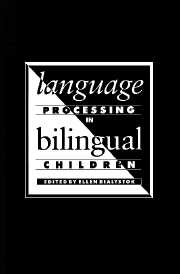Book contents
- Frontmatter
- Contents
- List of figures
- List of tables
- List of contributors
- Preface
- Introduction
- 1 Language modules and bilingual processing
- 2 Phonological processing in two languages
- 3 Second-language learning in children: a model of language learning in social context
- 4 Interdependence of first- and second-language proficiency in bilingual children
- 5 Giving formal definitions: a linguistic or metalinguistic skill?
- 6 Metalinguistic dimensions of bilingual language proficiency
- 7 Translation skill and metalinguistic awareness in bilinguals
- 8 Towards an explanatory model of the interaction between bilingualism and cognitive development
- 9 Constructive processes in bilingualism and their cognitive growth effects
- 10 Language, cognition, and education of bilingual children
- Index
3 - Second-language learning in children: a model of language learning in social context
Published online by Cambridge University Press: 11 January 2010
- Frontmatter
- Contents
- List of figures
- List of tables
- List of contributors
- Preface
- Introduction
- 1 Language modules and bilingual processing
- 2 Phonological processing in two languages
- 3 Second-language learning in children: a model of language learning in social context
- 4 Interdependence of first- and second-language proficiency in bilingual children
- 5 Giving formal definitions: a linguistic or metalinguistic skill?
- 6 Metalinguistic dimensions of bilingual language proficiency
- 7 Translation skill and metalinguistic awareness in bilinguals
- 8 Towards an explanatory model of the interaction between bilingualism and cognitive development
- 9 Constructive processes in bilingualism and their cognitive growth effects
- 10 Language, cognition, and education of bilingual children
- Index
Summary
In this chapter I discuss a view of language learning that has evolved from a decade and a half long period of research on the learning of English by young children for whom English is a second language. My goals in a series of longitudinal studies have been to understand the nature of the process, and to discover what causes the variation that exist among learners in respect to the ease with which they learn the new language. I have been particularly interested in the interplay of cognitive and social factors in the learners, with situational and linguistic factors in the settings in which learning takes place. In all, I have studied the development of English in well over 200 five- to eleven-year-old children, some of them for as long as three years.
In this chapter, I discuss the model of language learning that emerged from that decade and a half long program of research. The word ‘emerge’ is used advisedly. The model was not an a priori view of language learning that led to the sequence of studies mentioned above: it evolved post hoc as I attempted to reconcile the sometimes contradictory findings from the investigations of individual factors in language learning.
- Type
- Chapter
- Information
- Language Processing in Bilingual Children , pp. 49 - 69Publisher: Cambridge University PressPrint publication year: 1991
- 106
- Cited by



